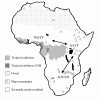The structure of biodiversity - insights from molecular phylogeography
- PMID: 15679920
- PMCID: PMC544936
- DOI: 10.1186/1742-9994-1-4
The structure of biodiversity - insights from molecular phylogeography
Abstract
DNA techniques, analytical methods and palaeoclimatic studies are greatly advancing our knowledge of the global distribution of genetic diversity, and how it evolved. Such phylogeographic studies are reviewed from Arctic, Temperate and Tropical regions, seeking commonalities of cause in the resulting genetic patterns. The genetic diversity is differently patterned within and among regions and biomes, and is related to their histories of climatic changes. This has major implications for conservation science.
Figures



Similar articles
-
The extreme disjunction between Beringia and Europe in Ranunculus glacialis s. l. (Ranunculaceae) does not coincide with the deepest genetic split - a story of the importance of temperate mountain ranges in arctic-alpine phylogeography.Mol Ecol. 2012 Nov;21(22):5561-78. doi: 10.1111/mec.12030. Epub 2012 Oct 12. Mol Ecol. 2012. PMID: 23057869
-
Genetic consequences of climatic oscillations in the Quaternary.Philos Trans R Soc Lond B Biol Sci. 2004 Feb 29;359(1442):183-95; discussion 195. doi: 10.1098/rstb.2003.1388. Philos Trans R Soc Lond B Biol Sci. 2004. PMID: 15101575 Free PMC article. Review.
-
Comparative phylogeography highlights the double-edged sword of climate change faced by arctic- and alpine-adapted mammals.PLoS One. 2015 Mar 3;10(3):e0118396. doi: 10.1371/journal.pone.0118396. eCollection 2015. PLoS One. 2015. PMID: 25734275 Free PMC article.
-
Unravelling biodiversity, evolution and threats to conservation in the Sahara-Sahel.Biol Rev Camb Philos Soc. 2014 Feb;89(1):215-31. doi: 10.1111/brv.12049. Epub 2013 Jul 13. Biol Rev Camb Philos Soc. 2014. PMID: 23848599 Review.
-
Phylogeography and biogeography of the lower Central American Neotropics: diversification between two continents and between two seas.Biol Rev Camb Philos Soc. 2014 Nov;89(4):767-90. doi: 10.1111/brv.12076. Epub 2014 Feb 3. Biol Rev Camb Philos Soc. 2014. PMID: 24495219 Review.
Cited by
-
Centers of endemism of freshwater protists deviate from pattern of taxon richness on a continental scale.Sci Rep. 2020 Sep 2;10(1):14431. doi: 10.1038/s41598-020-71332-z. Sci Rep. 2020. PMID: 32879396 Free PMC article.
-
The evolutionary history of the Arabidopsis lyrata complex: a hybrid in the amphi-Beringian area closes a large distribution gap and builds up a genetic barrier.BMC Evol Biol. 2010 Apr 8;10:98. doi: 10.1186/1471-2148-10-98. BMC Evol Biol. 2010. PMID: 20377907 Free PMC article.
-
Whole genome sequencing and the application of a SNP panel reveal primary evolutionary lineages and genomic variation in the lion (Panthera leo).BMC Genomics. 2022 Apr 22;23(1):321. doi: 10.1186/s12864-022-08510-y. BMC Genomics. 2022. PMID: 35459090 Free PMC article.
-
Mature habitats associated with genetic divergence despite strong dispersal ability in an arthropod.BMC Evol Biol. 2007 Apr 2;7:52. doi: 10.1186/1471-2148-7-52. BMC Evol Biol. 2007. PMID: 17407568 Free PMC article.
-
Testing evolutionary hypotheses about species borders: patterns of genetic variation towards the southern borders of two rainforest Drosophila and a related habitat generalist.Proc Biol Sci. 2009 Apr 22;276(1661):1517-26. doi: 10.1098/rspb.2008.1288. Epub 2009 Feb 25. Proc Biol Sci. 2009. PMID: 19324823 Free PMC article.
References
-
- Avise JC, Arnold J, Ball RM, Bermingham E, Lamb T, Neigel JE, Reeb CA, Saunders NC. Intraspecific phylogeography: The mitochondrial DNA bridge between population genetics and systematics. Annual Review of Ecology and Systematics. 1987;18:489–522.
-
- Avise JC. Phylogeography: the history and formation of species. Cambridge, Mass., Harvard University Press; 2000. pp. 1–447.
-
- Carson HL. Chromosome tracers of the origin of species. Science. 1970;168:1414–1418. - PubMed
-
- Avise JC. The history and purview of phylogeography: a personal reflection. Molecular Ecology. 1998;7:371–379. doi: 10.1046/j.1365-294x.1998.00391.x. - DOI
LinkOut - more resources
Full Text Sources

